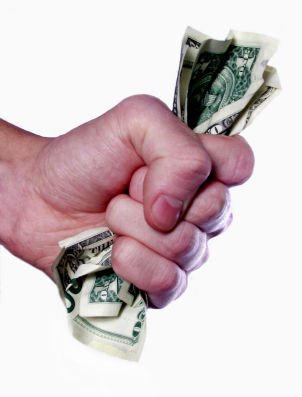Five Keys to Selling to Tightwads
 One out of four potential customers for your product may not buy it, even if the purchase makes economic sense or is otherwise a good decision. A couple of days ago, in Tightwads, Spendthrifts, and Everyone Else, I wrote about research that found people could be categorized by their spending behavior into three major groups. While the largest group, described as “unconflicted,” comprised 60% of the large sample of survey subjects, a quarter of the group were identified as “tightwads.” The latter group presents a unique marketing challenge because they will resist spending money even when the expense is reasonable and perhaps justified. How does a marketer not only make the case for her product, but get a tightwad to part with his money? Here are five tactics:
One out of four potential customers for your product may not buy it, even if the purchase makes economic sense or is otherwise a good decision. A couple of days ago, in Tightwads, Spendthrifts, and Everyone Else, I wrote about research that found people could be categorized by their spending behavior into three major groups. While the largest group, described as “unconflicted,” comprised 60% of the large sample of survey subjects, a quarter of the group were identified as “tightwads.” The latter group presents a unique marketing challenge because they will resist spending money even when the expense is reasonable and perhaps justified. How does a marketer not only make the case for her product, but get a tightwad to part with his money? Here are five tactics:
Minimize Buying Pain
Tightwads are characterized by an above normal sensitivity to buying pain. Research has characterized the pain of buying as being related to, among other things, the perceived fairness of the price and the immediate cash impact.
1. Make the price a bargain. Tightwads don’t like high prices, or prices that appear to be high for what they are buying. Sale prices may be more potent tools with this group. In a direct selling situation where the offer can be tailored to the individual, a price discount may help seal the deal. In most selling situations, though, discounting may not be a desirable option, or even a possibility. In these cases, it is possible that restating the price in different terms might help. An annual membership costing $120 might be described as “only $10 per month” or “only 33 cents per day.” In every case, you are trying to show the tightwad buyer how fair the price is.
2. Avoid repeated pain points. In Painful Sushi and Other Pricing Blunders, I talked about how per-item pricing (as in a sushi restaurant) creates a more painful buying situation than a one time, all-inclusive price (as in a seafood buffet). Since tightwads are more sensitive to paying pain, avoid drip-drip-drip pricing structures that punish the buyer every time he does something. Obviously, not all selling situations allow this – Wal-Mart can’t adopt “per cart” or “all you can buy” pricing. But many products and services, including internet service, cell phone service plans, health club memberships, physical products with options, etc., are possibilities for including a la carte items in a package price.
3. Create product bundles. This is closely related to the previous point. One effect of package pricing is to disguise individual pain points, as has been noted by neuroeconomics expert George Loewenstein. One example he cites is the bundling of car accessories, like leather seats, power features, and so on into a single “luxury package.” This avoids the multiple pain points of selecting separately priced items, and also disguises the individual prices. If the packaged items were sold individually, the consumer would have to make a specific decision on whether leather seats were worth an extra $1,000, a power moonroof $900 more, and so on. Even though the package may cost as much as, or even more than, the individual components priced separately, there’s less buying pain involved.
One good thing: if you can reduce the buying pain associated with your offer, you’ll almost certainly do better with the vast majority of your potential customers. All but the most extreme spendthrifts do feel some buying pain, and a less painful offer will help with more than tightwad customers.
Other Tightwad Techniques
4. Appeal to important needs. Tightwads are less likely to be seduced by the sex appeal of a product than other types of buyers. One of the experiments conducted by the CMU researchers was to present an offer of a $100 massage couched either in utilitarian terms (relief of back pain) vs. hedonic terms (a pleasurable experience). While tightwads were 26% less likely to buy the hedonic massage than the spendthrifts, they lagged by only 9% for the utilitarian massage. Most products combine a variety of characteristics, and the utilitarian ones may be most important to emphasize when selling to tightwads.
5. Watch Your Language! One rather startling finding in the CMU research was that changing the description of an overnight shipping charge on a free DVD offer from a “$5 fee” to a “small $5 fee” increased the response rate among tightwads by 20%! This is hardly inventive copywriting and didn’t involve any fancy neuromarketing, but the mere reminder that $5 was a small amount of money had an important effect on tightwads.
So, don’t write off a big chunk of your potential customers as too cheap to bother marketing to. Instead, refine your approach to your tightwad customers and you’ll steal market share from your less aware competitors and boost sales across the board.
